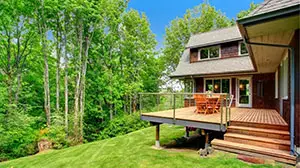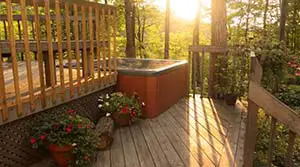
One of the worst things in the world is to have your deck rained on before the new stain dries. Different defects, such as pockets and white spots, will appear.
These pocks and white spots will affect the appearance of your deck. Fortunately, there are many different ways to avoid and fix this problem.
Having rain stained on your newly varnished deck is unfortunate, although this can be a typical encounter. This is more frequent to those living in humid areas or timed with the weather.
Of course, there’s nothing best to do except to prevent it. Here are seven problems you may encounter on your newly stained deck when it rains:
- Rain can ruin decking
- Rain can cause damage when the deck stain is not dry
- Problems with wet deck stains
- Water stains on newly stained deck
- Rain damage to deck wood or stain
- Best stains for a rainy climate
- Best types of deck wood in a rainy climate
Read on to discover the problems that a downpour can cause before your deck stain dries.
1. Rain Can Ruin Decking
First, if it ever rained on your deck just after sealing it, then you know the symptoms of weather damage. Stains that have linseed or mineral oil in them are the most prone to damage from downpours.
Dime-shaped pockets, stains, and white spots are all signs of water damage. Water beading and drying on the deck will cause these marks.
Meanwhile, the stain itself can look splotchy, it can flake, and there may even be bubbles on the surface. If this happens, it ruins the appearance of the deck and damages the stain. Water displaces the color and soaks into the pores of the deck. Water is doing what the paint should do.
You should apply stain to your deck when there is no rain in the forecast. You can use water-based deck stains in damp weather. In many cases, light precipitation or drizzle will not cause issues.
The deck stains that require you to hose off the deck after application are usually the most water-resistant. Other mitigating factors include:
- The type of wood
- How much it rained
- How long it rained
2. Rain Can Cause Damage When the Deck Stain is Not Yet Dry
In general, you should follow the following guidelines to avoid rain damage to your deck stain:
- Do not apply deck stain to wood until 48 hours after it has rained.
- Water-based and latex-based deck stains will only need 4-6 hours to dry.
- Oil-based deck stains need 12-24 hours to dry and will receive more damage overall than water-based stains.
- If it rains heavily frequently, apply the deck stain once a year.
- The length of precipitation determines the amount of damage your deck stain will get from the weather.
As long as you stick to these general guidelines, the weather will not damage your deck, your deck will not trap moisture, and you will not have to replace your deck wood because of rot.
3. Problems with Wet Deck Stains
When your deck stain does not dry, it probably was misapplied. Many customers who have this experience say that the deck stain is sticky and not solid. The stickiness could have happened for many reasons:
- The first coat of deck stain did not dry before the application of the second coat.
- It was too humid out.
- The first coat was too thick.
- The wood could not absorb the deck stain coat.
If you remember doing any of these, you can take the following steps:
| Problem | Solution | Steps |
|---|---|---|
| The wood did not absorb all of the deck stain coat | Thin the stain using paint thinner | 1. Identify the tacky or sticky part of the deck 2. Apply the paint thinner Dry 3. Use a wood cleaner 4. Apply a heavy stain 5. Wipe off any extra stain |
| It was too humid out | Reapply the deck stain | 1. Strip the stain 2. Resand the deckReapply the stain |
| The deck stain was too thick | Reapply the deck stain and mix well | 1. Strip the stain 2. Resand the deck 3. Mix the deck stain throughout reapplication |
| I applied a second coat of color before the first one dried | Wash the deck stain | 1. Wash the deck with paint thinner |
4. Water Stains on Newly Stained Deck
Rain will damage your deck and alter the stain if the stain does not have enough time to dry. The water tries to displace the deck stain.
In addition to aesthetic defects, there may also be moisture damage, which might require you to replace the entire deck.
Getting Wet Before the Deck Dries
If your newly stained deck gets wet before it dries, you should follow this procedure:
- Make sure the deck has dried.
- Try to reapply the stain on the defective spot.
- If this does not work, then try a wood cleaner and a power washer.
- If this does not work, sand the deck and restain – but use sparingly as the deck stain could flake.
Apply a Finish Remover
If all else fails, you might have to strip the stain off the deck and restain the deck. Follow these steps:
- Apply a finish remover, such as ABR Fast Finish Remover.
- Test the stripper to make sure it works.
- Apply it until it completely darkens the deck.
- Clean the deck using a pressure washer set at 600-800 PSI and hold the nozzle at 40 degrees to avoid stop and start marks
- Remove excess water
- Let dry until damp
- Apply a wood restorer, such as ABR X-180 Wood Restorer, with a sprayer, roller, or brush.
- Use the pressure washer again at the same PSI.
- Apply stain with a pad or brush (do not use a roller) by back brushing with the grain.
Olive Oil Treatment
Deck owners have also found some ingenious solutions, including using olive oil for rain damage on oil-based stains:
- Make sure the deck is completely dry.
- Apply olive oil to a clean rag within 24-48 hours.
- Use the rag to blend the spots in.
- Restain.
This method will last for at least ten months.
Some of these methods are labor-intensive, while others do not take much time. Restaining your deck is the most labor-intensive method and is a perfect example of why you should know what weather is coming in the next few days before you stain your deck.
5. Rain Damage to Deck Wood or Stain
Fortunately, you can avoid rain damage to a newly-stained deck by using a water seal in rainy climates. To apply a water seal, apply deck cleaner after staining. Then, use a push broom to spread the sealer.
A sealer can be applied within 4 hours of a stain and offers four years of protection. Sealers are especially useful in rainy climates, such as London and Seattle, since the weather can be unpredictable.
Examples of a water seal include:
- Seal-Once Marine Wood Sealer, Waterproofer, & Stain
- Rust-Oleum Ultimate Spar Urethane
- Thompson’s Water Seal VOC Wood Protector
In places where it rains frequently, a water sealer is an absolute must as it will provide a double-layer of protection both for your stain and your deck wood.
6. Best Stains for a Rainy Climate
If you live in an area with a rainy climate, such as Seattle or London, a water-based, mildew-resistant, low-pigmented stain is the best to use.
We recommend this type of stain because it is breathable, has a low odor when you apply it, is mildew resistant, and provides a non-slip surface.
You can also use this type of stain in damp weather. The only downside to a water-based deck stain is high maintenance.
There are also other types of stains that you can use:
| Type of Stainer | Advantages | Disadvantages |
|---|---|---|
| Oil-Based | Has both transparent and sheen finishes | – Mix time is longer – Dry time is longer – The weather has to be dry to apply – Can provide a place for mildew to grow – Made of volatile organic compounds (VOCs), which are bad for the environment – Fades over time |
| Gel-based | The deck will only need light sanding | – Over 48 hours of drying time |
| Lacquer Stain | Dries within minutes | – Strong odor – Protective equipment is needed |
| Varnish Stain | Dries in less than a day Hardens quickly | – Commonly used as a top coat of deck stain |
| Metallic Dye Stain | Quick Dry Time Can be thinned if needed | – Usually used as a finish – Fades under prolonged exposure to the sun |
7. Best Types of Deck Wood in a Rainy Climate
You should know the climate regardless of whether you are building a deck on your own or want to buy a house with a prebuilt deck.
We recommend that you use a type of hardwood for your deck. Hardwood has a natural hard grain and is moisture-resistant. These two factors make them perfect for a rainy climate, such as Seattle or London.
Here are the best types of hardwoods to use in areas with rainy climates:
| Type of Wood | Advantages | Disadvantages |
|---|---|---|
| Cedar | – Insect-resistant – It can last for 20 years without rot, warping, or splitting | |
| White Oak/Teak | – Resistant to warping, cracking, twisting, and decay – Low maintenance – Rot-resistant – Moisture-resistant – Insect-resistant | |
| Ipe (Rainforest Wood) | – Insect-resistant – Rot-resistant – Fire-resistant – 25-year warranty | – You can only know if the harvesting was environmentally responsible and has the Forest Stewardship Council trademark |
| Western Red Cedar | – Sun-resistant – Heat-resistant – Cold-resistant | – Splinters easily – Requires a penetrating stain |
| Redwood | – Resists rot | – Will blacken if it experiences prolonged exposure to moisture – Requires a clear sealer |
Final Thoughts
If your deck has dime-sized pockets, white spots, and flaking, then your deck stain was not completely dry before it rained. Fortunately, most of this damage can be avoided by simply staining the deck when there is no rain in the forecast.
Rain damage to your newly-stained deck is easily avoidable. With a quick look at the forecast, a water sealer, and the correct type of stain and wood, you will be able to avoid rain damage to your deck in a rainy climate.
Make sure you choose the right deck stain for your weather and make sure it will not rain heavily for the next few days, and you can avoid the problems associated with precipitation on a deck stain that has not dried.
Sources













